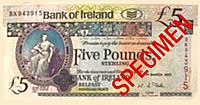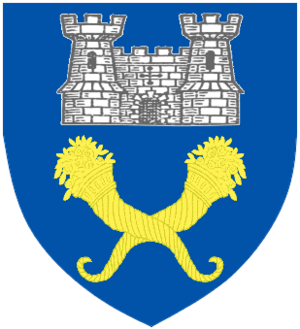Bank of Ireland facts for kids
| Public | |
| Traded as | Euronext Dublin: BIRG LSE: BIRG ISEQ 20 component |
| ISIN | [https://isin.toolforge.org/?language=en&isin=IE00BD1RP616 IE00BD1RP616] |
| Industry |
|
| Founded | 5 April 1783 |
| Headquarters | Upper Baggot St, Dublin, Ireland |
|
Area served
|
|
|
Key people
|
|
| Products |
|
| Revenue | €7,817 million (2023) |
|
Operating income
|
€4,428 million (2023) |
| €1,601 million (2023) | |
|
Number of employees
|
10,845 (2023) |
Bank of Ireland Group plc (Irish: Banc na hÉireann) is a large commercial bank that operates in Ireland and the United Kingdom. It is one of the four biggest banks in Ireland. Bank of Ireland has a special place in Irish history because it is a very old and important financial organisation.
The main part of the bank today comes from the original "Governor and Company of the Bank of Ireland." This old institution was started by a special royal permission in 1783. Since late 2014, the European Central Bank has directly supervised Bank of Ireland. This means it is a very important bank in Europe.
A Look Back at Bank History
Bank of Ireland is the oldest bank in Ireland that has been open continuously. It only closed for short times during bank strikes in the 1950s, 1960s, and 1970s.
How the Bank Began
In 1781, the Parliament of Ireland passed a law called the Bank of Ireland Act 1781. This law officially created the Bank of Ireland. The bank first opened its doors on June 25, 1783. It was located in a private house at St Mary's Abbey in Dublin.
In 1808, the Bank of Ireland moved to a much bigger building. This was the former Parliament House at 2 College Green. By 1827, the bank had seven branches outside of Dublin. These were in cities like Belfast, Cork, and Waterford.
Growing Through the Years
- In 1864, Bank of Ireland started paying interest to people who kept their money in savings accounts.
- By 1883, the bank had 58 branches across Ireland. This number grew to 75 by 1920.
- In 1922, Bank of Ireland became the official banker for the Government of Ireland.
- The bank grew by taking over other banks. It took control of the National Land Bank in 1926 and the Hibernian Bank Limited in 1958.
- In 1965, Bank of Ireland acquired the Irish branches of the National Bank Ltd.
- In 1969, Bank of Ireland, Hibernian Bank, and the National Bank of Ireland all merged. This created the Bank of Ireland Group we know today.
Modern Banking Services
- In 1980, Bank of Ireland introduced its first ATM. These were called "Pass Machines."
- The bank celebrated its 200th birthday in 1983. A special stamp was made to mark the occasion.
- In 1990, Bank of Ireland started offering Visa credit cards.
- Telephone banking was introduced in 1996, allowing customers to manage their money over the phone.
- In 1997, Bank of Ireland launched Internet banking. This allowed people to do their banking online.
- In 1996, the bank bought the Bristol and West building society in the UK.
- In 2002, Bank of Ireland bought a large share in Iridian, an investment company in the US.
Challenges and Changes
In 2008, there were concerns about the bank's financial health. The Irish government provided a large amount of money to help the bank in 2009. This was part of a rescue plan.
In 2010, the European Commission asked Bank of Ireland to sell off some of its businesses. This happened because the bank had received help from the Irish government.
In 2013, Bank of Ireland increased interest rates on some mortgages. This was to help the bank hold more money in reserves.
In September 2022, the Irish government sold its remaining shares in the bank. This meant that Bank of Ireland became fully owned by private investors again, for the first time in ten years.
Bank's Role for the Government
Bank of Ireland has never been the central bank of Ireland. The central bank is a different organisation. However, Bank of Ireland did perform many important functions, similar to a central bank, for a long time. For example, it managed the government's main account. From 1922 until 1971, Bank of Ireland was the official banker for the Irish Government.
Bank Headquarters

For many years, the main office of Bank of Ireland was the impressive Parliament House on College Green in Dublin. This building was designed in 1729 to be the home of the Irish Parliament. It was the first building in the world built specifically for a parliament with two separate chambers.
After the Act of Union 1800 in 1800, the Irish Parliament no longer met. Bank of Ireland bought the former Parliament House in 1803. This building is still used as a bank branch today. Visitors can even see the old Irish House of Lords chamber inside. The current Irish parliament, the Oireachtas, now meets in Leinster House.
In the 1970s, the bank moved its main office to a modern building called Miesian Plaza on Lower Baggot Street. In 2010, the bank moved again to a smaller headquarters on Mespil Road. In 2021, Bank of Ireland announced another move for its headquarters.
Today, Bank of Ireland's main office is at Baggot Plaza, 27-33 Upper Baggot Street, Dublin 4.
Banking Services for Customers
Bank of Ireland has its main office in Dublin. It also has operations in the Republic of Ireland, Northern Ireland, Great Britain, and other parts of the world.
In the Republic of Ireland
The bank offers many financial services in Ireland. These include:
- Checking and savings accounts
- Loans for homes (mortgages)
- Loans for businesses
- Credit cards
- Services for managing money and investments
In 1969, Bank of Ireland had 500 branches in the Republic of Ireland. By 2022, the number of branches had been reduced to 169.
In Northern Ireland
In Northern Ireland, Bank of Ireland has a special right to print its own banknotes. These are in Pounds Sterling. In 2021, the number of branches in Northern Ireland was reduced from 28 to 13.
In Great Britain
In Great Britain, Bank of Ireland grew by taking over the Bristol and West Building Society in 1996. The bank also offers savings accounts through the Post Office across the UK.
Around the World
Bank of Ireland Corporate Banking provides services in other countries. These include France, Germany, Spain, and the United States.
Banknotes
Even though Bank of Ireland is not a central bank, it can print its own money in the United Kingdom. This is because of a legal right that dates back to before Ireland was divided. These notes are in pound sterling and have the same value as notes from the Bank of England. They are different from the old Irish pound banknotes.
The front of Bank of Ireland banknotes shows the bank's logo. Below it are shields representing the six counties of Northern Ireland. There is also a picture of a figure called Hibernia, who represents Ireland. Around her is the bank's Latin motto: Bona Fides Reipublicae Stabilitas, which means "Good Faith is the Cornerstone of the State."
The current series of £5, £10, and £20 notes, issued in April 2008, show the Old Bushmills Distillery on the back. Before 2008, all Bank of Ireland notes featured an image of the Queen's University of Belfast.
The different banknotes have different colours and sizes:
- £5 note: blue
- £10 note: pink
- £20 note: green
- £50 note: blue-green
- £100 note: red
Bank of Ireland has never printed its own banknotes in the Republic of Ireland. A law in 1927 removed the right for Irish banks to issue their own notes. However, "consolidated banknotes" were issued by several banks, including Bank of Ireland, between 1929 and 1953. These notes were not official legal money.
Bank's Coat of Arms



